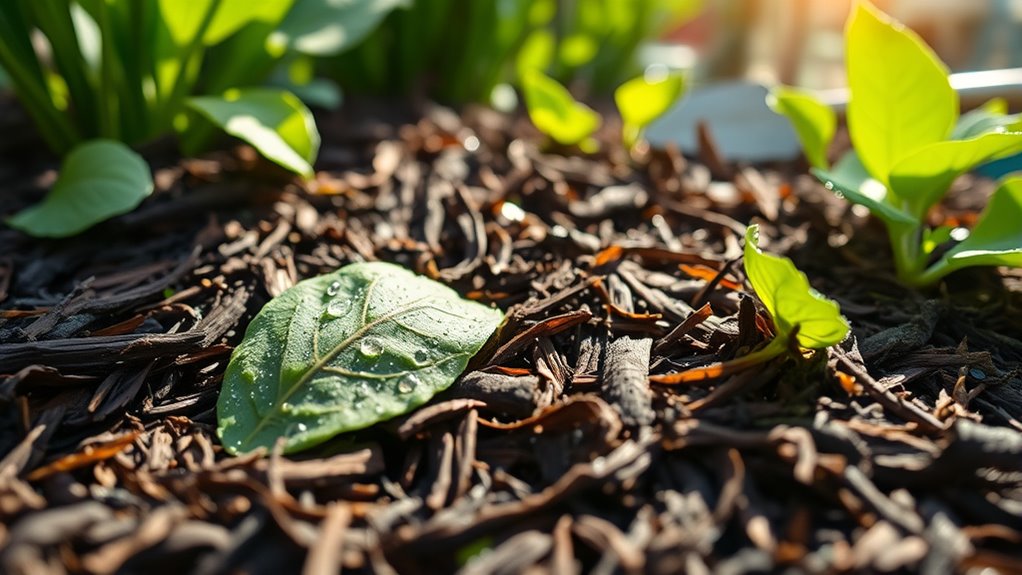Mulching works by insulating your soil, keeping it cooler in summer and warmer in winter, which helps plants grow healthier. It also locks in moisture, reducing evaporation and watering needs, while suppressing weeds by blocking sunlight. Choosing the right mulch type and depth is essential—organic mulches add nutrients as they break down, while inorganic options last longer but don’t enrich soil. Avoid common mistakes like applying too thick or too close to plant stems for best results—exploring these tips can boost your gardening success.
Key Takeaways
- Mulching insulates soil, regulating temperature and reducing evaporation to maintain consistent moisture levels.
- Organic mulches decompose, enriching soil fertility and supporting microbial activity and healthy root growth.
- Proper mulch depth (2-4 inches) prevents suffocation, promotes aeration, and avoids pest attraction.
- Inorganic mulches offer durable weed control and moisture retention but do not improve soil nutrients.
- Avoid thick mulching layers and contact with plant stems to prevent root rot, pests, and poor oxygen flow.
How Mulching Affects Soil Temperature and Moisture
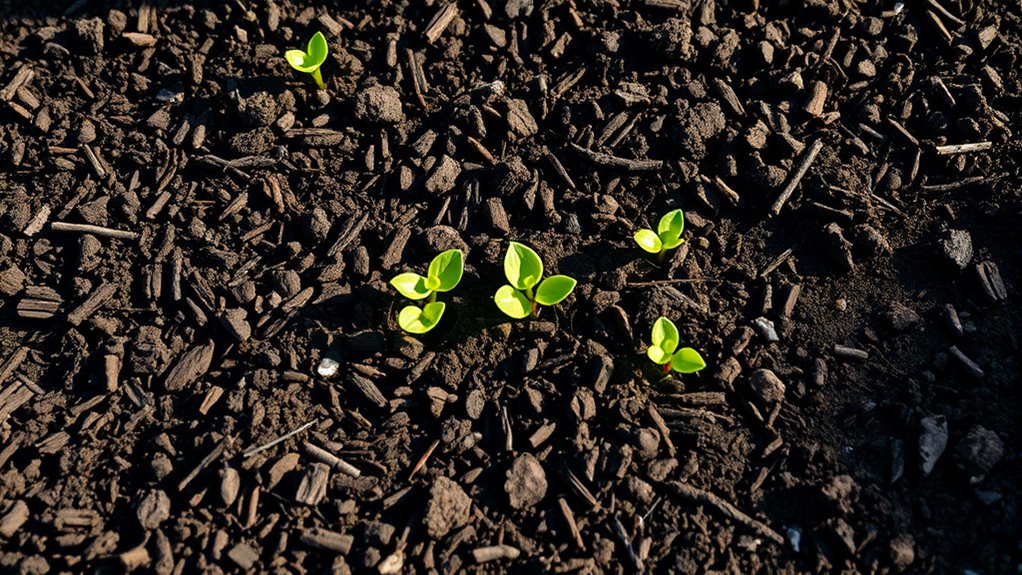
Mulching plays a crucial role in regulating soil temperature and moisture levels. When you apply mulch, it insulates the soil, keeping it cooler in the summer and warmer in the winter. This temperature regulation benefits plant roots and supports healthy growth. Mulch also helps maintain consistent moisture, reducing evaporation and watering needs. By preserving moisture, you create ideal conditions for soil aeration, allowing air to reach plant roots more effectively. Additionally, mulch suppresses weeds by blocking sunlight, preventing them from taking over your garden beds. This weed suppression minimizes competition for nutrients and water, making it easier for your plants to thrive. Proper mulching creates a more stable environment, ensuring your garden stays healthy and productive year-round. Understanding sound components can further enhance your knowledge of creating optimal growing conditions.
The Role of Organic Versus Inorganic Mulches
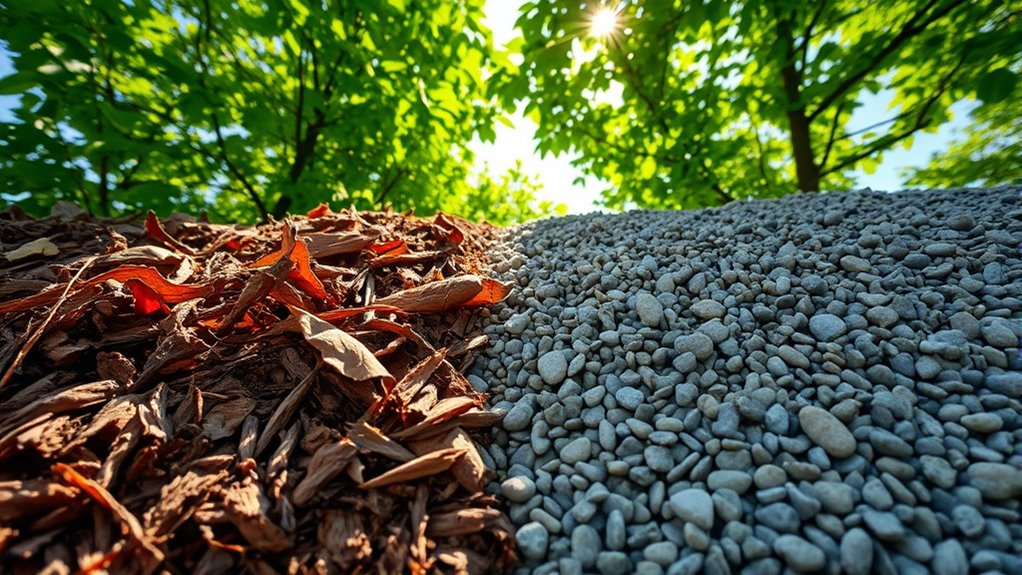
Have you ever wondered how organic and inorganic mulches differ in function and benefits? Organic mulches, like bark or straw, often have a natural mulch color and a coarse mulch texture that helps improve soil fertility as they decompose. They also retain moisture and regulate soil temperature effectively. In contrast, inorganic mulches such as rubber or plastic usually come in uniform mulch colors and have a smooth or textured surface that repels weeds and lasts longer. While inorganic options don’t enrich the soil directly, they are excellent for weed control and moisture conservation. Your choice depends on your specific gardening needs—organic mulches add nutrients over time, whereas inorganic mulches provide durability and consistent appearance. Understanding these differences helps you select the best mulch for your garden. Vetted
Choosing the Right Mulch Depth for Optimal Benefits
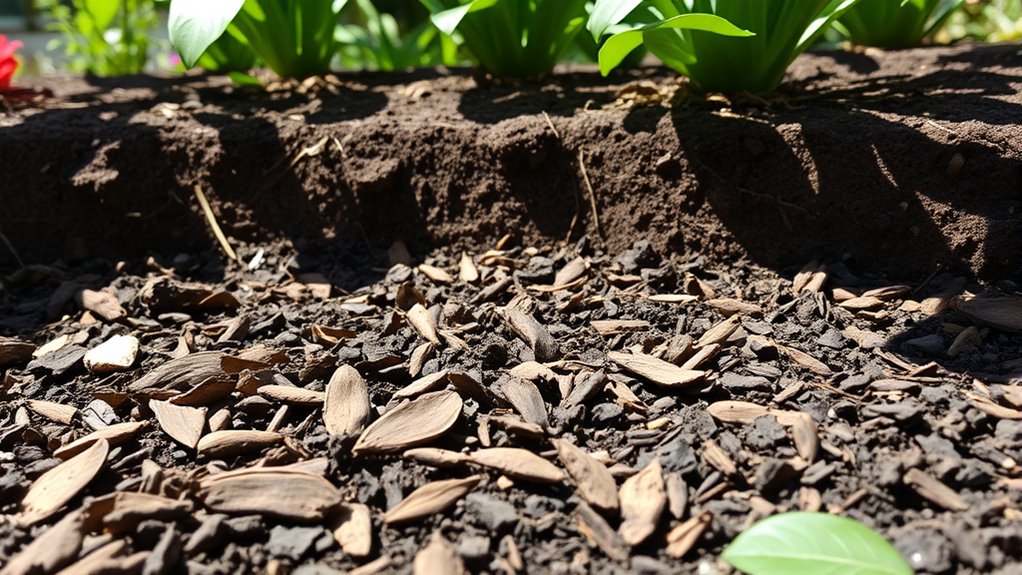
Choosing the right mulch depth guarantees you maximize the benefits of your mulching efforts. Proper mulch layering ensures soil moisture retention, weed suppression, and temperature regulation. Typically, a depth of 2 to 4 inches works well for most garden beds. Applying too little mulch won’t provide adequate coverage, while too much can suffocate plants or cause rot. Use effective mulch application techniques by spreading evenly and avoiding piling mulch against plant stems or trunks. For vegetable beds and flower borders, stick to the recommended depth to avoid compaction and ensure healthy root growth. Regularly check and adjust mulch layers as needed, especially after heavy rain or wind, to maintain suitable coverage. Proper mulch depth maximizes soil health, plant vigor, and the overall success of your garden. Additionally, maintaining the correct mulch thickness helps prevent issues like compaction and promotes healthy root development.
The Impact of Mulch Materials on Soil Health and Plant Growth
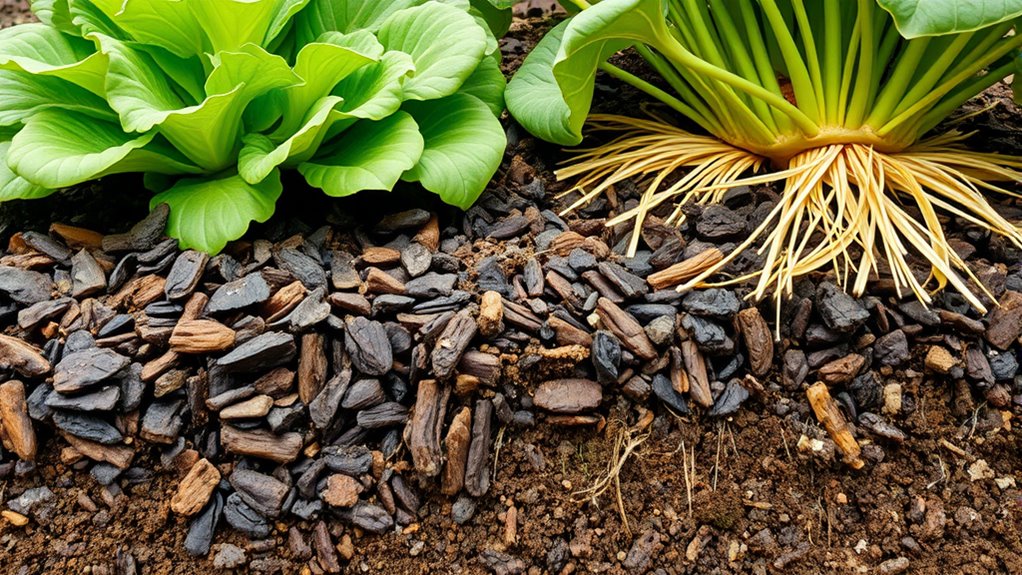
The type of mulch material you select directly influences soil health and plant growth, as each material interacts differently with the environment. Organic mulches, like wood chips or straw, undergo mulch decomposition, gradually enriching the soil with nutrients and improving its structure. This process supports beneficial microbial activity and enhances soil aeration, allowing roots to breathe and access nutrients more effectively. In contrast, inorganic mulches like plastic or gravel don’t decompose, offering long-lasting coverage but limited soil benefits. Your choice impacts how well the soil retains moisture, stays aerated, and fosters healthy plant roots. Selecting the right mulch material ensures suitable soil conditions, promotes vigorous growth, and maintains long-term soil vitality. mulch decomposition is a key factor that influences the overall benefits of organic mulching practices.
Common Mulching Mistakes and How to Avoid Them
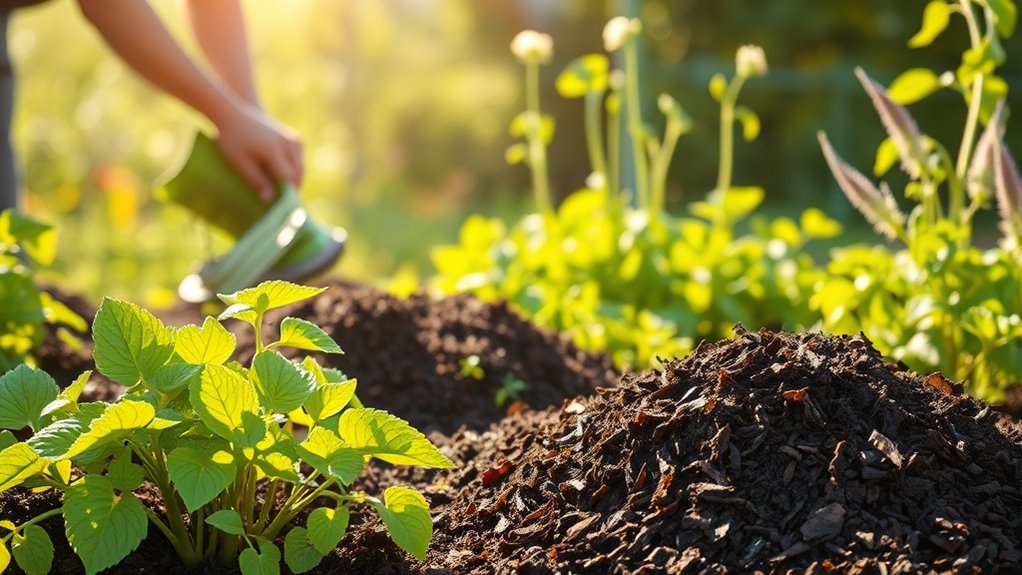
One common mistake gardeners make is applying mulch too thickly, which can suffocate plant roots and cause moisture retention problems. Proper mulch application means spreading a layer about 2-3 inches deep, ensuring airflow and preventing waterlogging. Over-mulching creates a barrier that limits oxygen, increasing the risk of root rot and disease. Additionally, thick mulch layers can attract pests like termites or rodents seeking shelter. To avoid this, keep mulch a few inches away from plant stems and trunks. Regularly inspect your mulch for compaction or pest activity, and refresh it as needed. Good mulch application not only promotes healthy soil and plant growth but also enhances pest prevention, reducing the need for chemical controls and supporting a thriving garden ecosystem.
Frequently Asked Questions
How Does Mulching Influence Weed Suppression Over Time?
Mulching effectively suppresses weed growth over time by blocking sunlight and making it difficult for weeds to germinate. As you maintain consistent mulching, its longevity guarantees continued weed control, reducing the need for herbicides or manual removal. Over time, a thick layer of mulch becomes even more effective, preventing new weeds from establishing roots. Regular replenishment keeps the mulch’s weed suppression capabilities strong, maintaining a tidy, weed-free garden or landscape.
What Are the Environmental Impacts of Synthetic Mulches?
Synthetic mulches might seem like the superhero of weed control, but they come with environmental side effects. You risk chemical leaching that could poison your soil and water, and they often don’t decompose, turning your garden into a plastic nightmare. Instead, consider biodegradable alternatives—eco-friendly options that break down naturally, preserving your garden’s health and saving the planet from a plastic invasion. Your plants and the Earth will thank you.
Can Mulching Help Manage Soil Erosion Effectively?
Yes, mulching effectively manages soil erosion by stabilizing soil and reducing runoff. When you apply mulch, it helps retain soil moisture, which keeps the soil structure intact and less prone to erosion. Mulching acts as a protective barrier against wind and water forces, enhancing erosion control. By maintaining proper soil moisture levels, you create a healthier environment for plants and prevent the loss of valuable topsoil.
How Often Should Mulch Be Replenished for Best Results?
You should replenish mulch every 1 to 3 years, depending on its mulch life cycle and type. Organic mulches decompose faster, so they need more frequent replenishment, usually annually. Synthetic mulches last longer, often several years, requiring less frequent replacement. Regularly inspect your mulch to maintain soil protection and prevent weeds. Keep in mind, replenishing guarantees your mulch continues to suppress erosion, conserve moisture, and improve soil health effectively.
Are There Specific Mulching Techniques for Different Plant Types?
Think of mulching as dressing each plant in its own unique outfit. For plant-specific mulching, choose materials that suit each type’s needs—like bark for trees and straw for vegetables. This technique enhances moisture retention and protects roots. Pay attention to each plant’s growth habits and water needs, adjusting your mulching approach accordingly. By customizing your method, you guarantee healthier plants and a thriving garden.
Conclusion
By understanding the science behind mulching, you can boost your garden’s health and productivity. Did you know that properly mulched soil can retain up to 50% more moisture? Avoid common mistakes like over-mulching or using the wrong material, and you’ll see healthier plants and richer soil. With the right practices, you’ll not only save water but also create a thriving garden environment. Start mulching smarter today and watch your garden flourish!
